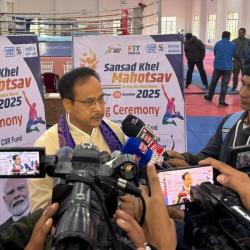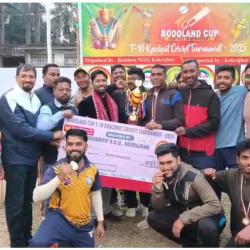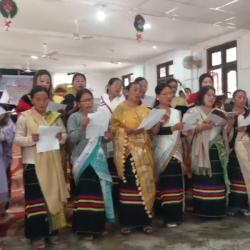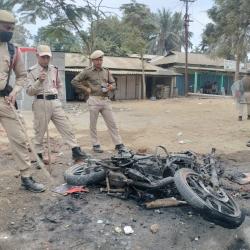Non-Dimasas demand separate council
Assam government’s dubious decisions and bias actions are giving birth to new problems for the
peaceful citizens of the state day by day. The Dimasa dominated North Cachar Hills Autonomous Council
had earlier in the year 2008 demanded to change the name of the district after the Dimasa. The district’s
Non-Dimasa people raised their voice against this demand. They formed a new platform to protest by
the name of Indigenous Peoples’ Forum (IPF).
The Government of Assam bowed down before the tyrannical demand of DHD(J) to change the districts
name as Dima Hasao on March 30,2010 in the backdrop of the rupees thousand crore scam in the
district, said IPF General Secretary, Ngaidam Puruolte, while addressing the media persons in Guwahati
on October 30,2012.
He said that the N C Hills Autonomous District Council was formed in 1952 with a view to bring about
all round development to the various backward Hill Tribal people of the N C Hills district. At the time of
its inception of the Council there were six (6) members from Dimasa community and an equal number
of non-Dimasa communities. The agreement among the leaders of that time was reached that if the
lone member of the state Assembly is Dimasa, the Chief Executive Member (CEM )of the Council would
be a non-Dimasa and vice versa. Accordingly, a Dimasa, J B Hagzer was the first MLA from the district
and a Hmar Chawnhau Khawthlang became the first CEM of the Council. However, this agreement
could not last for long and Chawnhau Khawthlang remained the first and last CEM from the non-Dimasa
community.
There were delimitations of the MDC constituencies to the council in the years 1967 and 1978 in which
the number of the Dimasa members was increased from 6 to 15 and that of Non Dimasas from 6 to 8
only. After these delimitations, the Dimasas applied their policy of dominating the Council. On the other
hand, the innocent non-Dimasas remained unaware of their hidden designs and were satisfied to remain
peaceful under communal harmony, Puruolte said.
He alleged that the Dimasas through their students’ organization, the Dimasa Students’ Union
(DSU) raised slogans as ‘Cachar for Kacharis’ and’ N C Hills for Dimasas’ and claimed that 90 percent
reservation of all government jobs and other facilities for the Dimasas in early 1980s. At this point,
the non-Dimasas could know about their evil designs and to fight against it they formed a non-Dimasa
platform called All Tribal Integrated Committee (ATIC). A rift between Dimasas and non-Dimasas
emerged in the history of NC Hills‘ politics from that time, the IPF leaders explained.
The Dimasas in their attempt to turn the district into exclusively theirs, tried to change the name of the
district after the word Dimasa into Dima Halali in 2001.The non-Dimasas also to counter their move
formed a forum in the name of Indigenous Tribes Front (ITF). Due to strong opposition the proposal for
the change of name of the district was dropped.
Afterwards, the Dimasas switched over to ethnic cleansing policy. In their attempt to oust other tribes
one by one from the district started waging ethnic clashes with the help of the DHDs against the Hmar
in 2003, against the Karbis in 2005 and against the Zeme Nagas in 2009. By this the Dimasas dominated
over the N C Hills Autonomous Council and tried to change district’s name and ultimately succeeded
by signing a peace accord for Dima Hasao Territorial Council by both factions of Dimasas through a
tripartite agreement with Government of India and Assam government on October 8,2012. The N C Hills
district was renamed by ‘force’ Dima Hasao on March 30,2010, the IPF alleged.
It may be mentioned in this connection that Dima Hasao district has 35 percent population of Dimasas
according to electoral rolls of 2008. However, considering all the facts non-Dimasas are disappointed
and feel that there is no chance for survival of non-Dimasa communities in Dima Hasao district and
therefore they demand for creation of a separate non-Dimasa Autonomous District for them. The non-
Dimasas argument is that if for 35 percent population of Dimasas an autonomous district could be
constituted there is no harm in constituting an autonomous council for 65 percent non-Dimasas. Their
demand is to give them a home land where they can live in peace, IPF leaders said.
Other Contents by Author
It is strange in a state like Assam that the government fails to provide full security and safety to the people's life and property and at the same time, it does not allow the citizens to 'purchase' it from other sources. It is alleged by different sections of the people that they are victim of the double standard of the state government. They allege that neither the government provides them security nor it allows them to get from other sources. Although the state government has claimed from time to time having provided full security, the actual position appears too far from such claims. Reports of killing, abduction and different modes of violence are coming out unabated almost every day...
Under the Indian Rhino Vision 2020 (IRV2020) plan about 3,000 wild rhinos are to be translocated in seven protected areas of Assam by the year 2020. This was disclosed to a group of journalists, who visited the Manas National Park on April 12 last, to have a glance of first batch of translocated rhinos from Pabitora Wildlife Sanctuary in Morigaon district, under the scheme. Two rhinos were brought to Manas National Park from the Pabitora on 12th morning. IRV 2020 is an ambitious programme of the Government of Assam in collaboration with World Wildlife Foundation India supported by the International Rhino Foundation and the US Fish and Wildlife Service. Its main objective is to increase the...
Purno Agitok Sangma, a veteran politician, Nationalist Congress Party leader and former Lok Sabha Speaker, who opted for return to the state politics, has a very important and crucial role to play in Meghalaya. With formation of the Meghalaya Progressive Alliance (MPA), which took the rein of state administration on March 19 last, Sangma has the responsibility to head the State Planning Board. The post of the Chairman of the Planning Board is considered to the rank of the Chief Minister.The MPA is an alliance of 31 members, in which the Nationalist Congress Party (NCP) is the largest partner with 14 members. The United Democratic Party (UDP) has 11and the Bharatiya Janata Party (BJP) only...
It was in Meghalaya, a nine days drama in power. The recent Assembly elections did not give a clear mandate to any political party. The Hung House compelled the political rivals to forge alliances, which came into existence in the form of Meghalaya United Alliance (MUA) led by the Congress Party and the Meghalaya Progressive Alliance (MPA), a combination of Nationalist Congress Party (NCP), United Democratic Party (UDP) and others. Both the alliances claimed to form the government and approached the Governor, S.S.Sidhu with their claims. Since the Congress Party was the largest single party with 25 members, it was allowed to form the government and prove the confidence of the House within...
All India Regional Rural Bank Employees Association (AIRRBEA) has opposed the entry of foreign and private banks in rural areas. Criticizing the announcement of Union Finance Minister, P. Chidambaram, in his recent budget speech in the Parliament, the AIRRBEA general secretary Dilip Kumar Mukherjee said that his organization did not agree on minister's proposal as this attempt would 'take away' the basic fabric of the agricultural character of the country and make the entire 'Green field' into 'Gray field'. He was addressing the media persons recently at Guwahati Press Club.The AIRRBEA representing majority of the officers and employees of the country strongly opposed the move of Government...
Army's Red Horn Division organized a public rally on 29 January 2008 at Patharighat in Darrang district, bout 70 kilometers away from the state capital Guwahati, to pay homage to the martyrs, who had laid down their lives in supreme sacrifice while protesting against the brutalities and oppressive rule of the Britishers in January 1894. Major Gen. Gyan Bhushan, AVSM,VSM of Red Horn Division was the chief guest at the function.It may be mentioned here that at Patherighat on 28 January 1894, the farmers of the village protested against unjustified increase in land revenue by the erstwhile British Empire. The farmers belonging to various castes, creed and religion had risen against the British...
Seven years ago from now eight street children were picked up from Guwahati Railway Station by a noble person dedicated to the service of humanity. These children were rehabilitated in a hut in Dhirenpara locality of the city. This rehabilitation centre named 'Snehalaya' (House of affection) became operational on January1, 2001. 'Snehalaya' is an out-reach programme of the Don Bosco Educational Society for rehabilitation of children in need of care and protection. With the motto 'to take them off the street and put them on their feet', Fr Lukose Cheruvalel, SDB, the Founder Director of Snehalaya started living with those children. He was loved by the children by the core of their heart...
Complaints of human rights violation are very common now days. Allegations and counter allegations are pouring almost every day from various corners of the northeastern region. The root cause of such violations is the growing militancy in the area. In order to curb militant activities the security forces have to do combing operations in different part of the region. The militants some how try to establish their hideouts in the interior areas.In order to escape from the clutches of security forces the ultras engage themselves in firing on their targets, the security forces. The security forces, in retaliation, though take every care to protect civilians a few incidents of casualty occur,...
The industrial development in India has been dependent on the political influence and leadership ever since independence. It was because of the fact that no fair policy could be framed for equal development of all the regions of the country simultaneously. That is why some of the areas remained completely neglected and the others developed beyond limit resulting in heavy congestion. Besides, the metropolis and a few big industrial centers where opportunities are ample for industrial growth, there is vast disparity in the growth of industries in various regions. The industrialization of a particular area depends on the degree of political influence it has in its favour. A few industries...
The Central government is giving top priority to the development of the Northeastern region, as this region continues to be backward in comparison to other parts of the country even after sixty years of independence. There are several reasons for its backwardness, prominent among them are lack of perfect leadership and will power to implement the centrally sponsored schemes. The growing unemployment has bred the menace of insurgency in the entire region. Violence continues unabated affecting even the meager developmental activities. Reluctance of skilled workforce and technicians to work under 'security threat' has adversely affected developmental activities.With the primary objective of...










Comments
Pages
Add new comment